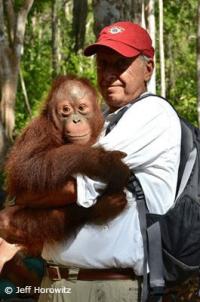Living dangerously
Interview with Jeff Horowitz, co-producer for the Emmy Award-winning climate change documentary series, ‘Years of Living Dangerously’.
Why is it important for people to understand the connection between forests, deforestation and climate change? And how important are protected areas in this equation?
Most people around the world are not aware of the critical connection between deforestation and climate change. Burning forests add two billion tonnes of carbon pollution per year – almost 20% of the total emissions problem.
Deforestation creates more carbon pollution than all of the cars, trains and planes in the world combined – making Indonesia and Brazil the third and fourth largest emitters of greenhouse gases (just after the United States and China).
While it’s critical that people understand the relationship between deforestation and climate change, it’s even more important to ensure that they know that ending deforestation is the most immediate, scalable, and cost-effective of all the solutions to climate change. And establishing and enforcing protected areas is without question the best tool for avoiding deforestation.
How did ‘Years of Living Dangerously’ expose the benefits and challenges of establishing protected areas?
In episode two of ‘Years of Living Dangerously’ we had actor-conservationist Harrison Ford fly over Tesso Nilo – an 83,000 hectare national park in Riau Province, Sumatra, Indonesia. What Harrison and all of us saw was shocking: Almost 80% of this park was completely deforested!
Fires that had been set to clear the forestland for plantations were still smoldering, while heavy equipment prepared the ground for thousands of palm oil seedlings. When we were discussing how to put together this piece for American television network Showtime, it was really important for us to show this footage so that people could see that even land that has been declared ‘protected’ is at risk. In this case, it was clear that ‘protected’ meant very little to those who felt that these trees – a national treasure – were worth more dead than alive. Yes, declaring a land area to be a public park is a great first step, but all of us need to help ensure that promise and performance go hand-in-hand.
How did ‘Years’ connect to the general public in a way that may inspire action?
Tesso Nilo was destroyed because of the enormous global demand for palm oil. The fact is, palm oil is used in an endless list of foods and other consumer products, from cooking oils to ice cream! We wanted to make this connection very clear to the audience. So we show Harrison’s incredibly visceral reaction to the devastation of Tesso Nilo, and then show him on a palm oil plantation, and later at a plant that uses palm oil as it manufactures many of its products. Our hope was that our audience came away thinking that they could help shift the balance by simply choosing different products to put in their grocery basket.
The good news is that there is indeed enough land around the world to grow palm oil sustainably, without taking down more forests. Some companies, like Unilever, are making great strides to help shift the marketplace to ‘deforestation free’ palm oil. But much more work needs to be done to encourage additional companies to recognise this problem and turn to similar enlightened practices. The bottom line is, the more that the public is aware of this problem around the world, the greater is the potential for change.
Jeff Horowitz is founder of Avoided Deforestation Partners (www.adpartners.org), a global network of prominent individuals who are dedicated to advancing US and international climate policies, with a particular focus on ending deforestation.







